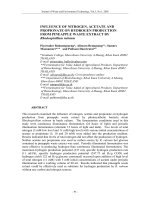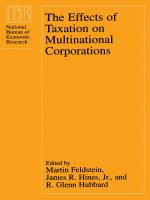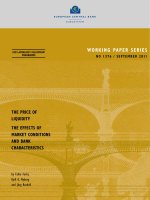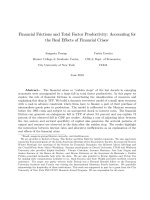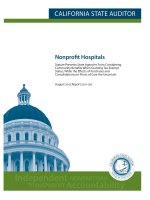Effects of Environmental Parameters on Hydrogen Production of Strain Clostridium beijerinckii CB3 Is
Bạn đang xem bản rút gọn của tài liệu. Xem và tải ngay bản đầy đủ của tài liệu tại đây (359.34 KB, 11 trang )
<span class='text_page_counter'>(1)</span><div class='page_container' data-page=1>
258
Effects of Environmental Parameters on Hydrogen Production
<i>of Strain Clostridium beijerinckii CB3 Isolated </i>
in North of Vietnam under Anaerobic Condition
Nguyen Thi Hong Hue
1, Pham Duc Ngoc
1, Tran My Hanh
1,
Ngo Anh Tien
2, Bui Thi Viet Ha
1,*1
<i>Faculty of Biology, VNU University of Science, 334 Nguyen Trai, Hanoi, Vietnam </i>
2
<i>Laboratory of Applied Micro and Nanotechnology, Technical University of Denmark </i>
Received 02 June 2016
Revised 02 August 2016; Accepted 09 Septeber 2016
<b>Abstract: Hydrogen is considered as an ideal substitute to fossil fuels in the energy and </b>
non-polluting characteristics. Biological hydrogen production using microorganisms is a promising
method to the world's energy industry. The anaerobic, mesophilic, Gram-positive strain
<i>Clostridium beijerinckii CB3 (C. beijerinckii CB3) isolated from cattle feces in North of Vietnam </i>
has been studied to optimize the biohydrogen production in anaerobic condition. In this study, the
<i>effects of culture conditions on hydrogen production by C. beijerinckii CB3 were investigated in </i>
batch culture using serum bottles. Various medium components (carbon and nitrogen sources,
inorganic salts) and environmental factors (initial pH, temperature of incubation), time and orbital
<i>shaker of culture were optimized for hydrogen production by C. beijerinckii CB3. The optimal </i>
parameters for the best growth and biohydrogen production in batch tests were incubation time 48
h, 37oC, pH 8.5, and orbital shaker 200 rpm. The maximum cell growth of 1.6 in OD600 and
biohydrogen production of 881.25 mL/L were obtained, respectively, in the medium containing 10
g/L of glucose, 10 g/L of yeast extract or 10 g/L of peptone, 480 mL/L of NaHCO3, and 32 mL/L
of K2HPO4<i>. These results indicated that C. beijerinckii CB3 is a potential candidate for </i>
fermentative biohydrogen production.
<i>Keywords: Biohydrogen production, C. beijerinckii, culture condition, growth, anaerobic </i>
condition.
<b>1. Introduction*</b>
Hydrogen is recognized as a clean,
renewable and promising energy alternative for
the future since it is efficient and
environmentally friendly. It has the highest
_______
*
Corresponding author. Tel.: 84-4-38588856
Email:
</div>
<span class='text_page_counter'>(2)</span><div class='page_container' data-page=2>
waste. Fermentative hydrogen producers belong
to anaerobic acid forming bacteria such as
<i>Clostridium sp. [1, 3], Enterobacter sp. [1] and </i>
<i>Bacillus </i>sp. [4] isolated from bioreactors and
<i>natural environments. Clostridium is one of </i>
the highly -effective hydrogen producers
within the Firmicutes phylum, and many
strains of which have been isolated and
studied (Leena B et al, 2010, Wang et al.,
<i>2008; Dan An et al., 2014) [5-7]. Clostridium </i>
<i>beijerinckii</i> recently has been found to be
capable of biohydrogen production [7, 8].
Previous studies [9-11] indicated that the
culture conditions (e.g., substrate
concentration, inoculums, pH, nitrogen
source, metal ion, temperature, etc.)
significantly affect on the cell growth and
<i>hydrogen production. Dan An et al., [7] </i>
studied the effects of pH, temperature, xylose
concentration on hydrogen yield of
<i>Clostridium beijerinckii</i> YA001, the highest
yield of hydrogen (2.31 mol/mol xylose) was
obtained at pH of 8.0 and temperature of
40°<i>C. Yokoi et al., [12] performed a repeated </i>
batch culture using a mixed culture of
<i>Clostidium </i> <i>butyricum</i> and <i>Enterobacter </i>
<i>aerogene</i>, the hydrogen yield was 2.4 mol H2
<i>/mol glucose. Fang et al. [13] carried out an </i>
experiment on bio-hydrogen production by
<i>Clostridium</i> sp. using rice slurry containing
5.5 g carbohydrate L-1. After a 36-h
acclimation period, the sludge showed
maximum hydrogen production of 346 mL H2
g-1 carbohydrate. Although culture conditions
have been investigated widely, the optimal
culture conditions for different species or
strains vary.
The aim of the present study was
investigated deals with the optimization of
culture conditions for bio-hydrogen
<i>production using C. beijerinckii CB3 isolated </i>
from cattle feces. In addition, the effects of
culture temperature, pH, substrate
concentration, nitrogen source, inorganic
salts, time and orbital shaker on hydrogen
production were investigated.
<b>2. Materials and methods </b>
<i>2.1. Materials and culture medium </i>
The anaerobic, mesophilic, Gram - positive,
<i>hydrogen-producing strain C. beijerinckii CB3 </i>
<i>was isolated and identified as C. beijerinckii </i>
CB3 in Biochemistry and Environmental
microbiology Laboratory, Center for Life
Science Research, VNU-University of Science
(data not show).
The synthetic medium used for growth
bacterial, PY medium (1 L) [5] contained 10 g
glucose, 10 g peptone, 10 g yeast extract,
reazurine: 1 mg, salts solution: 40 mL, H2O 960
mL. 100 mL salts solution composed of:
KH2PO4: 0.1 g, K2HPO4: 0.1 g, NaHCO3: 1 g,
NaCl: 0.2 g, CaCl2: 0.02 g, MgSO4: 0.02 g,
Clarified rumen fluid 50 mL, pH = 7.0.
<i>2.2. Experimental conditions </i>
The PY medium was dispensed
anaerobically into 15 mL anaerobic culture
bottles. Prior to testing, the bottles containing 8
mL liquid medium were sealed with rubber
plugs and autoclaved at 121oC for 20 min.
Then, they were flushed with ultra high-pure
nitrogen gas (99.999%) for 20 min. The bottles
were shaken in an air bath at 150 rpm.
Inoculated with 10% (w/v) colony and
incubated at 35°C, pH 7.0. The hydrogen gas
was collected by the gas-tight syringe after
culture for 48 h. To determine the effects of
culture conditions on growth and hydrogen
production, parameters including time,
temperature, pH value, carbon sources,
substrate concentration, nitrogen source,
inorganic salts, orbital shaker were alternately
varied.
<i>2.3. Analytical methods </i>
</div>
<span class='text_page_counter'>(3)</span><div class='page_container' data-page=3>
experiment. Hydrogen gas in the headspace was
sampled with a gas-tight syringe (100mL
injection volume) and determined by a gas
chromatograph (GC, Outlet gas Inlet N2 from
gas tank) equipped with a thermal conductivity
detector (TCD) and a 2 m stainless column
packed with carboxen 1000, 50/80 mesh
(Supelco). Volume of hydrogen was determined
by the water displacement method.
<b>3. Results and discussion </b>
<i>3.1. Effects of culture time to the growth and </i>
<i>hydrogen production </i>
The culture time of growth and hydrogen
production using glucose as a substrate is given
in Figure 1. Growth and hydrogen production
<i>of strain C. beijerinckii CB3 were observed at </i>
culture time ranging from 0 to 72 h with an
optimal incubation time of 48 h.
Fig 1. Effects of culture time to the growth and
<b>hydrogen production. </b>
Figure1 showed that over time, both cell
biomass and hydrogen production increased
gradually. From time points 0 h to 6 h, cell
biomass increased slowly, resulting the OD660
values of 0.032-0.094 and hydrogen yield
achieved to be 0 - 10.83 mL/L medium,
respectively. After 12 hours, hydrogen yield
began to increase rapidly. From 12 h to 36 h
hydrogen production increased rapidly from
40.38 to 365.13 mL/L medium, then increased
slowly at an optimal time of 48 h. Hydrogen
production and OD600 obtained their highest
values of 581 mL/L medium and 1.469,
respectively. This can be explained that, by the
cells entered the rapid growth phase, cell
biomass increased along with increasing
metabolism, and hydrogen production increased
rapidly. After 48 hours hydrogen production
generated diminutively according cells entered
the decline phase.
<i>3.2. Effect of carbon source to the growth and </i>
<i>hydrogen production </i>
Carbohydrate is a major component in the
culture medium and is one of the most
important factors affecting growth and
hydrogen production. The various carbohydrate
substrates used in the study such as glucose,
xylose, lactose, maltose, sucrose and cellulose.
Carbohydrate substrates were added to the
culture medium PY with the concentration of
10 g/L. The result was obtained in Figure 2.
</div>
<span class='text_page_counter'>(4)</span><div class='page_container' data-page=4>
<i>Citrobacter</i> sp. CMC -1, H2 production in
optimal conditions (pH 6.0 and 34°C) achieved
1.82 ± 12.02 mol H2/mol glucose [16].
Regarding the use of lactose as carbohydrate
substrate, our result indicates that lactose is
also found to be a favorable carbohydrate
substrate to the cell growth and hydrogen
production, probably because it is a
disaccharide consisting of glucose and
galactose.. In a study by Dan An et al., (2014),
when using lactose as carbohydrate source,
<i>hydrogen production level of C. beijerinckii </i>
YA001 reaches 58.9 mL/g substrate [7]. Their
data also indicates that maltose is an alternative
suitable carbohydrate substrate for hydrogen
production with achieved yield of 40.9 mL/g
substrate. Regarding other substrates such as
sucrose, cellulose, and xylose, our data
indicates that they are not suitable carbon
sources for growth and hydrogen production of
<i>C. beijerinckii </i> CB3. This result can be
explained by their nature or absence of
metabolic enzymes in the isolated strain. Taken
all the data, glucose was used as carbohydrate
source in all subsequent experiments.
<i>3.3. Effect of glucose concentration to the </i>
<i>growth and hydrogen production </i>
Glucose was added to the culture media
with the concentrations: 2, 4, 6, 8, 10, 12 or 14
g/L. Investigation of glucose concentration to
the growth and hydrogen production after 48h
was shown in Figure 3.
As can be seen on Figure 3, glucose
concentrations affected hydrogen production
<i>and growth of strain C. beijerinckii CB3. With </i>
the increase of glucose supplementation from 2
g/L to 10 g/L, the cell growth and hydrogen
yield increased, from 0.289 to 1.475 OD600
values and 37.82 to 600.70 mL/L respectively.
When low glucose concentration of 2 g/L, the
strain used quickly, then low hydrogen
production achieved 37.82 mL/L medium.
When glucose was added to the medium with
increasing concentrations, it was used as a
direct substrate source to the cell growth and
hydrogen production, cell biomass and
hydrogen yield increased rapidly and achieved a
maximum of 600.70 mL/L medium and OD600
value 1.475 after 48h at the concentration of
glucose was 10 g/L and then decreased. Cell
growth and hydrogen production were slowed
when the glucose concentration was higher than
10 g/L. The use of too much glucose bacteria
did not consume off to raise wasteful. At the
same time substrate utilization and final pH
decreased with increasing glucose
Fig.2. Effect of carbon source to the growth and
hydrogen production.
</div>
<span class='text_page_counter'>(5)</span><div class='page_container' data-page=5>
concentration, and some substrate remained
when the glucose concentration was over 10
g/L can cause decreasing emissions produced
when glucose levels rise. This observation was
coincided with previous studies. The results of
Dang Thi Yen et al., (2013), also resulted
optimum substrate of 10 g/L glucose by strain
Tr2 [18] and some other species such as
<i>Clostridium saccharoperbutylacetonicum</i> N1-4
(Alalayah et al) [19]. In the research of Xin
Zhao et al., a maximum hydrogen production
achieved at glucose concentration 9 g/L by the
<i>strain C. beijerinkii RZF 1108 [17]. </i>
Since concentrations of glucose using for
<i>growth and formation of hydrogen of C. </i>
<i>beijerinckii </i>CB3’s (10g/L) is lower than that of
<i>Clostridium sp. str. 6A-5 and C. butyricum EB6 </i>
<i>(16 g/L [20] and 15.7 g/L [21] respectively), C. </i>
<i>beijerinckii </i>CB3 will help save materials and
input costs if it is used.
<i>3.4. Effect of nitrogen source to the growth and </i>
<i>hydrogen production </i>
Nitrogen is a very important component in
growth and development of bacteria. In
laboratory scale, investigation of the growth
<i>and hydrogen production of C. beijerinckii CB3 </i>
through the ability to consume nitrogen sources
such as organic nitrogen: peptone (P), yeast
extract (Y), meat extract (M), inorganic
nitrogen (NH4Cl, NH4NO3) aimed to search for
a suitable nitrogen source for cultivation to
reach the highest hydrogen production.
Nitrogen sources were added to the basic
medium PY (BM) with the concentration of 10
g/L: BM+P (basic medium and peptone),
BM+Y (basic medium and yeast extract),
BM+M (basic medium and meat extract), BM +
PY (basic medium and both peptone, yeast
extract), BM + NH4Cl (basic medium and
NH4Cl), BM+ NH4NO3 (basic medium and
NH4NO3). The result was obtained and shown
in Figure 4, indicating that the strain can
consume 4 types of nitrogen sources including
BM+Y, BM+P, BM+M, and BM+PY among
the 6 tested nitrogen sources.
Fig.4. Effect of nitrogen sources to the growth and
hydrogen production.
</div>
<span class='text_page_counter'>(6)</span><div class='page_container' data-page=6>
coincides with previous studies of Leena et al
(2009) [5].
<i>3.5. Effect of culture pH to the growth and </i>
<i>hydrogen production </i>
pH is an important factor affecting
hydrogen fermentation because it affects
metabolism and hydrogenase activity. The
rapidly decreasing of pH value in culture
medium is the main reason leading to low
growth and hydrogen production during
culturing. Therefore, the initial pH becomes a
key factor to affect directly metabolism and
hydrogen production of studied bacterial strains
[20]. We tested various pH values of culture
medium, ranging from 5.0 to 9.5 ((adjusted by 1
mol/L HCl or 1 mol/L NaOH solution) to
determine the optimal value pH for the growth
and hydrogen production, and the result was
obtained and shown in Figure 5.
As shown on Figure 5, pH substantially
influenced on the growth and hydrogen
<i>production of C. beijerinckii CB3. The strain </i>
could grow and produce hydrogen at pH
ranging from pH 5.0 to 9.5 with hydrogen
production achieved 54.50 to 691.13 mL/L
medium. When the initial pH increased from
5.0 to 8.5, the hydrogen yield and cell biomass
also increased and reached a maximum at pH
8.5, the highest growth and hydrogen yield
achieved 691.13 mL/L medium with the OD600
value of 1.507 and then decreased gradually
when pH was increased further. In this study,
the optimum pH for hydrogen production using
<i>C. beijerinckii</i> CB3 was 8.5. The optimum pH
was slightly higher than the pH reported in
previous literatures. In the report by Taguchi et
al (1996 b), by adjusting to optimal pH 6.5,
<i>Clostridium </i>sp. strain no.2 can grow well in
glucose as carbon source and produce hydrogen
yield 2.4 mol / mol substrate [23]. Pan et al.
report that the optimum pHs for hydrogen
<i>production by C. beijerinckii Fanp3 are </i>
between 6.47 and 6.98 with glucose as carbon
source and using 150 mmol/L phosphate as
buffer [8]. Dan et al (2014) reported that low
phosphate concentrations shows weaker
capacity on maintaining pH during fermentation
process [7]. In this study, the optimal pH value
was 8.0 when using xylose as carbon source by
<i>C. beijerinckii</i> YA001.
<i>3.6. Effect of temperature to the growth and </i>
<i>hydrogen production </i>
We then further determined the optimal
temperature to the growth and hydrogen
production. The effect of culture temperature on
Fig.5. Effect of culture pH on the growth and
hydrogen production.
</div>
<span class='text_page_counter'>(7)</span><div class='page_container' data-page=7>
hydrogen production was investigated by
varying the temperature between 25oC and
50oC. The result was obtained and shown in
Figure 6. The growth and hydrogen production
of the strain were increasing at temperatures
from 25o C to 50oC with archived levels ranging
from 15.91 to 662.22 mL/L medium,
respectively. The optimal temperature was
37oC, which allowed maximal hydrogen
production and OD600 achieved values of
662.42 mL/L medium and 1.498, respectively.
The hydrogen production and growth then
decreased vs increasing temperature more than
37oC. Our obtained result coincides with
previous studies of Wang et al. (2003) when
<i>studying the hydrogen production of C. </i>
<i>bifermentans</i> on glucose substrate [6], and of
Leena B et al. when studying the hydrogen
<i>production of Clostridium sp. DMHC-10 with </i>
achieved yield of 3.35 mol H2/ mol glucose at
temperature of 370C [5]. In another study, Xin
Zhao et al., (2011) show that the optimum
<i>temperature to the hydrogen production by C. </i>
<i>beijerinckii</i> RZF 1108 is 35°C [17]. When
temperature increased from 45°C to 50°C
(suitable temperature to the growth of many
<i>thermophilic bacteria), C. beijerinckii CB3 </i>
exhibit very low growth and hydrogen
production. This is probably due to increase in
denaturation rate of enzymes (ferredoxin
oxidoreductase, phosphate acetyltransferase,
acetate kinase and hydrogenase) responsible for
the fermentative hydrogen production process
when the temperature exceeded the critical
point [24].
<i>3.7. Effect of NaHCO3 to the growth and </i>
<i>hydrogen production </i>
Inorganic elements such as P, K, Mg, Ca,
Na etc. are considered to play an important role
in the growth and hydrogen production of strain
<i>C. beijerinckii</i> CB3. In this study, the impact of
these elements on the growth and hydrogen
production of strain was investigated by
determining the optimal concentration of
inorganic substances such as NaHCO3 and
K2HPO4.
Fig.7. Effect of NaHCO3 concentration to the growth
and hydrogen production.
Fig.8. Effect of K2HPO4 concentration to the growth
and hydrogen production.
NaHCO3 is one of the major components in
salts solution of the basic culture medium.
Therefore, in this study, an appropriate
concentration of NaHCO3 was investigated for
</div>
<span class='text_page_counter'>(8)</span><div class='page_container' data-page=8>
result was obtained and shown in Figure 7. In
details, hydrogen production and growth
increased with increasing NaHCO3
concentrations (from 240 to 480 mL/L) and
hydrogen production levels achieved from
170.04 to 687.04 mL/L medium. The optimal
NaHCO3 concentration was 480 mL/L, at which
both hydrogen production and OD600 achieved
their highest values of 687.04 mL/L medium
and 1.503, respectively. By increasing further
NaHCO3 concentration, hydrogen production
and OD600 was gradually decreased. Therefore,
480 mg/L is the most suitable NaHCO3
concentration for growth and hydrogen
<i>production of C. beijerinckii CB3 at 150 rpm, </i>
37°C, glucose as carbohydrate source.
<i>3.8. Effect of K2HPO4 </i> <i>to the growth and </i>
<i>hydrogen production </i>
K2HPO4 is also one of the major
components in salts solution of the basic culture
medium. The salt play an important role in
maintaining pH and osmotic pressure of the
organism, may resulting in maintaining the
initial pH to affect greatly to the growth and
hydrogen production of research strain.
Therefore, in this study, we performed a similar
optimization of K2HPO4 concentration like
optimization of NaHCO3. K2HPO4 was added to
the culture medium at final concentrations of
24, 32, 40, 48, 56, 64 mg/L. The result was
obtained and shown in Figure 8. Hydrogen
production and growth increased with
increasing K2HPO4 concentration (from 24 to
32 mL/L) and hydrogen production achieved
371.08 to 743.67 mL/L medium with an
optimal K2HPO4 concentration of 32 mL/L.
Both hydrogen production and OD600 achieved
their highest values 743.67 mL/L medium and
1.518, respectively and then decreased
gradually when K2HPO4 concentration was
increased further. Therefore, K2HPO4
concentration of 32 mg /L is suitable for growth
<i>and hydrogen production of C. beijerinckii CB3 </i>
at 150 rpm, 37°C, glucose as carbohydrate
<i>source. This result shows that C. beijerinckii </i>
CB3 needs less K2HPO4 salt than Thermotoga
<i>neapolitana</i> in previous studies [25].
<i>3.9. Effect of orbital shaker to the growth and </i>
<i>hydrogen production </i>
Orbital shaker has been known to effect the
cell growth and hydrogen production. Upon
shaking, nutrients is circulated within a culture
flask, enabling bacteria growth and production
of hydrogen at higher level as well as to avoid
bacterial settlement on the flask bottom, which
would result in cell death from the lack of
nutrient availability. Also, shaking prevents
bacterial clumps or biofilm formation, ensuring
prolific bacterial reproduction. However, if
shaking rate is too high, it can create shear
which can damage bacterial cells [26]. Thus,
effect of orbital shaking on hydrogen
production was investigated by varying the
orbital shaking rate between 50 rpm and 400
rpm. The result was obtained and shown in
Figure 9.
Fig. 9. Effect of orbital shaker to tgrowth and
hydrogen production.
</div>
<span class='text_page_counter'>(9)</span><div class='page_container' data-page=9>
grew and produced hydrogen at highest level at
orbital shaking rate of 200 rpm. Shaking at
lower or higher speeds inhibited cell growth.
Our data is close to the data reported by
Dwierra, et al. (2000), in which the optimal rate
<i>is 250 rpm in case of culturing C. </i>
<i>paraputrificum </i>M-21 strain [27].
<i>3.10. Hydrogen production under optimal </i>
<i>conditions </i>
Combining all the optimized conditions
including 10 g/L of glucose, initial pH of 8.5,
370C, NaHCO3 concentration of 480 mL/L,
concentration K2HPO4 of 32 mL/L, orbital
shaker of 200 rpm, time 48h, yeast extract and
peptone as favorable nitrogen sources, we
obtained hydrogen production of 881.25 mL
H2/L medium and OD600 of 1.594. The
<i>hydrogen yields of C. beijerinckii CB3 was </i>
comparable to that obtained by other Clostridia
[5, 7, 17, 19].
<b>4. Conclusion </b>
The growth and biohydrogen production by
<i>C. beijerinckii </i>CB3 was optimum at pH 8.5,
37oC, NaHCO3 480 mL/L, K2HPO4 32 mL/L,
orbital shaker of 200rpm, time 48h, glucose
10g/L, yeast extract and peptone as favorable
nitrogen sources for cell growth and hydrogen
production. The maximal hydrogen yield and
OD600 was 881.25 mL/L medium and 1.594,
respectively. In conclusion, the strain is
potential for production of hydrogen using a
variety of carbon and nitrogen sources.
<b>Acknowledgements </b>
This research is funded by Vietnam
National University, Hanoi (VNU) under
project number QG.16.03.
<b>References </b>
[1] Das D, Veziroglu NT, Hydrogen production by
biological processes: a survey of literature, Int J
Hydrogen Energy 26 (2001) 13.
[2] Levin DB, Pitt L, Love M., Biohydrogen
production: prospects and limitations to practical
application, Int J Hydrogen Energy 29 (2004)
173-85.
[3] Kotay SM, Das D., Microbial hydrogen
<i>production with Bacillus coagulans IIT-BT S1 </i>
<i>isolated from anaerobic sewage sludge, Bioresour </i>
<i>Technol 98 (2007) 1183. </i>
[4] O-Thong Sompong, Prasertsan Poonsuk,
Karakashev Dimitar, Angelidaki Irini,
Thermophilic fermentative hydrogen production
<i>by the newly isolated Thermoanaerobacterium </i>
<i>thermosaccharolyticum</i> PSU-2, Int J Hydrogen
Energy 33 (2008), 124.
[5] Kamalaskar, Leena B, et al., High biohydrogen
<i>yielding Clostridium sp. DMHC-10 isolated from </i>
sludge of distillery waste treatment plant,
International journal of hydrogen energy 35(19)
(2010) 10639.
[6] Wang, CC, et al., Producing hydrogen from
<i>wastewater sludge by Clostridium bifermentans, </i>
Journal of Biotechnology 102(1) (2003) 83.
[7] An, D., Li, Q., Wang, X., Yang, H., & Guo, L,
Characterization on hydrogen production
<i>performance of a newly isolated Clostridium </i>
<i>beijerinckii</i> YA001 using xylose”, International
Journal of Hydrogen Energy 39(35) (2014) 19928.
[8] Pan CM, Fan YT, Zhao P, Hou HW, Fermentative
hydrogen production by the newly isolated
<i>Clostridium beijerinckii</i> Fanp3, Int J Hydrogen
Energy 33(20) (2008) 5383.
[9] S. Van Ginkel and S. Sung, Biohydrogen
production as a function of pH and substrate
concentration, Environ Sci Technol 35 (2011)
4726.
[10] H. Argun, F. Kargi, I. K. Kapdan and O. Oztekin,
Biohydrogen production by dark fermentation of
wheat powder solution: Effects of C/N and C/P
ratio on hydrogen yield and formation rate, Int. J.
Hydrogen Energy 33 (2008) 1913.
[11] M. L. Chong, N. A. A. Rahman, P. L. Yee, S. A.
Aziz, R. A. Rahim, Y. Shirai and M. A. Hassan,
Effects of pH, glucose and iron sulfate
concentration on the yield of biohydrogen by
</div>
<span class='text_page_counter'>(10)</span><div class='page_container' data-page=10>
[12] H. Yokoi, A. Saitsu, H. Uchida, J. Hirose, S.
Hayashi and Y. Takasaki, Microbial hydrogen
production from sweet potato starch residue, J
Biosci Bioeng 91 (2011) 58.
[13] H. H. P. Fang, C. Li and T. Zhang, Acidophilic
bio-hydrogen production from rice slurry, Int J
Hydrogen Energy 31(2005) 683.
[14] Kapdan, Ilgi Karapinar and Kargi, Fikret,
Bio-hydrogen production from waste materials,
Enzyme and microbial technology 38(5) (2005)
569.
[15] Gray, Clarke T and Gest, Howard, Biological
Formation of Molecular Hydrogen: A “hydrogen
valve” facilitates regulation of anaerobic energy
<i>metabolism in many microorganisms, Science </i>
148(3667) (1965) 186.
[16] Mangayil R et al, Fermentative Hydrogen
<i>production from different sugars by Citrobacter </i>
<i>sp</i>. CMC-1 in batch culture, International Journal
of Hydrogen Energy,Volume 36, Issue 23 (2011)
15187.
[17] Zhao, Xin, et al., Hydrogen production by the
<i>newly isolated Clostridium beijerinckii </i>
RZF-1108, Bioresource technology 102(18) (2011)
8432.
[18] Dang Thi Yen, Vuong Thi Nga, Lai Thuy Hien,
Nguyen Thi Thu Huyen, "Effect of environmental
<i>parameters on hydrogen production of Strain Tr2 </i>
isolated in Vietnam under microaerobic condition,
<i>Journal of science and technology 51c(5) (2016) </i>
<b>587. (Vietnamese). </b>
[19] Alalayah, Walid M, et al., Effect of environmental
parameters on hydrogen production using
<i>Clostridium saccharoperbutylacetonicum</i> N1-4
(ATCC 13564), American Journal of
Environmental Sciences 5(1) (2009) 80.
[20] Cai, Jinling, et al., Fermentative hydrogen
production by a new mesophilic bacterium
<i>Clostridium </i>sp. 6A-5 isolated from the sludge of a
sugar mill, Renewable energy 59 (2013) 202.
[21] Chong, Mei-Ling, et al., Effects of pH, glucose
and iron sulfate concentration on the yield of
<i>biohydrogen by Clostridium butyricum EB6, </i>
International journal of hydrogen energy 34(21)
(2009) 8859.
[22] Ferchichi et al., Influence of culture parameters on
<i>biological hydrogen production by Clostridium </i>
<i>saccharoperbutylacetonicum</i> ATCC 27021,
World Journal of Microbiology and
Biotechnology 21 (2005) 855.
[23] Taguchi et al., Continuous hydrogen production
<i>by Clostridium sp. strain no. 2 from cellulose </i>
hydrolysate in an aqueous two-phase system,
Journal of Fermentation and Bioengineering 82(1)
(1996) 80.
[24] Lee DJ, Show KY, Su A, Dark fermentation on
biohydrogen production: pure culture, Bioresous
technol 102 (18) (2011) 8393.
[25] Eriksen et al, Hydrogen production in anaerobic
and microaerobic <i>Thermotoga </i> <i>neapolitana</i>,
Biotechnol Lett 30(1) (2008) 103.
[26]<i> Narayanaswamy S., Plant cell and tissue culture, </i>
Tata McGraw-Hill Education, New Delhi, 1994.
[27] Evvyernie, Dwierra, et al, Identification and
<i>characterization of Clostridium paraputrificum </i>
M-21, a chitinolytic, mesophilic and
hydrogen-producing bacterium, Journal of bioscience and
bioengineering 89(6) (2000) 596.
Ảnh hưởng của các yếu tố môi trường đến khả năng tạo khí
<i>hydro của chủng vi khuẩn Clostridium beijerinckii CB3 phân </i>
lập ở Miền Bắc Việt Nam trong điều kiện kị khí
Nguyễn Thị Hồng Huệ
1, Phạm Đức Ngọc
1, Trần Mỹ Hạnh
1,
Ngô Anh Tiến
2,Bùi Thị Việt Hà
11
<i>Khoa Sinh học, Trường Đại học Khoa học Tự nhiên, ĐHQGHN, 334 Nguyễn Trãi, Hà Nội, Việt Nam </i>
2
</div>
<span class='text_page_counter'>(11)</span><div class='page_container' data-page=11>
<i>Clostridium beijerinckii CB3 (C. beijerinckii CB3) được phân lập từ phân gia súc ở Miền Bắc Việt </i>
Nam có khả năng sản xuất hydro trong điều kiện ki khí. Trong nghiên cứu này, ảnh hưởng của các
<i>điều kiện nuôi cấy trên sản xuất hydro bởi chủng C. beijerinckii CB3 đã được nghiên cứu trong nuôi </i>
cấy mẻ. Các thành phần của môi trường (nguồn cacbon và nitơ, muối vô cơ) và các yếu tố môi trường
<i>(pH ban đầu, nhiệt độ), thời gian và tốc độ lắc đã được tối ưu hóa cho sản xuất hydro bởi chủng C. </i>
<i>beijerinckii</i> CB3. Các thông số tối ưu cho sản xuất hydro sinh học trong các thử nghiệm gồm: thời
gian nuôi cấy 48h, glucose 10g/L, cao nấm men và pepton là nguồn nitơ thích hợp, NaHCO3
480mL/L, K2HPO4 32 mL/L, nhiệt độ 370C, pH 8.5, tốc độ lắc 200rpm. Sản lượng hydro và giá trị
OD600 tối đa đạt được lần lượt là 881.25 mL/L môi trường và 1.594. Những kết quả này cho thấy C.
<i>beijerinckii </i>CB3 là một sinh vật tiềm năng cho lên men sản xuất hydro.
<i>Từ khóa: Sản xuất hydro sinh học, điều kiện ni cấy, C. beijerinckii CB3, sinh trưởng, điều kiện </i>
</div>
<!--links-->
